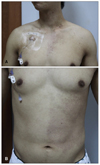Dear Editor:
Unilateral nevoid telangiectasia (UNT) syndrome is a rare vascular dermatosis, characterized by areas of superficial telangiectases distributed in a dermatomal, unilateral pattern usually on the upper trunk and extremities. The etiopathogenesis is not completely understood, but the most widely accepted theory is its association with hyperestrogenic condition1. Herein, we report a rare case of UNT accompanied by liver metastasis of colon cancer. A 26-year-old male presented with progressive asymptomatic erythematous telangiectactic patches localized to the left chest and abdomen of 5-month duration. Three months after from when he had noticed skin lesions, he was diagnosed with colon cancer with multiple metastases at lumbar spine, lung, intra-abdominal lymph nodes including the liver and started chemotherapy following the FOLFIRI (fluorouracil, leucovorin, and irinotecan) regimen. He had no history of hepatitis or alcoholism. No family members were known to have any similar condition. On physical examination, there were no palmar erythema, ascites, or hepatosplenomegaly suggestive of chronic liver disease. On examination of the skin, erythematous telangiectactic patches on the left chest and abdomen involving dermatomes C3-4 and T4-10 were observed (Fig. 1). Biopsy specimen of the skin revealed intact epidermis with thin-walled capillaries in the superficial dermis (Fig. 2). Immunohistochemical staining was negative for estrogen, progesterone, and vascular endothelial growth factor (VEGF) receptors. Laboratory investigations were within normal range including liver function test. However, circulating estrogen level (155.55 pg/ml; normal range, 40~115 pg/ml) and serum carcinoembryonic antigen level (329.50 ng/ml; normal range, 0~4.7 ng/ml), which may be due to colon cancer and multiple metastases. Based on clinical and histopathologic findings, a diagnosis of UNT syndrome accompanied by liver metastasis of colon cancer was made. Reported cases of UNT syndrome mostly occur in women during pregnancy or puberty and in men with alcoholic cirrhosis2. Rarely, it has also been described in patients with carcinoid tumor of stomach with liver metastasis3. Several cases reported in recent years have cast doubt on the view that estrogen is the causal agent of telangiectasia development because of normal estrogen levels or negative estrogen and progesterone receptors14. Turan et al.4 suggested that VEGF may play a role in the pathogenesis of UNT syndrome in patients with underlying hepatic disease. On the other hand, Smith et al.5 reported a case of UNT syndrome accompanied by chronic hepatitis C virus infection, with a normal serum estrogen profile and VEGF level but strong positive immunohistochemical staining of lesional skin with VEGF. They suggested this result supports the hypothesis that angiogenic factors play a role in the pathogenesis of UNT syndrome. VEGF is already known to be a commonly expressed angiogenic factor in human colorectal cancer metastases and high serum VEGF level is correlated with colon cancer liver metastasis. Despite being unable to check serum VEGF level, elevated estrogen and VEGF levels could be related to the pathogenesis of UNT syndrome in our patient who had colon cancer with multiple metastases including the liver. To our knowledge, this is the first report of UNT syndrome accompanied by liver metastasis of colon cancer.
Figures and Tables
References
1. Tok J, Berberian BJ, Sulica VI. Unilateral nevoid telangiectasia syndrome. Cutis. 1994; 53:53–54.
2. Wilkin JK, Smith JG Jr, Cullison DA, Peters GE, Rodriquez-Rigau LJ, Feucht CL. Unilateral dermatomal superficial telangiectasia. Nine new cases and a review of unilateral dermatomal superficial telangiectasia. J Am Acad Dermatol. 1983; 8:468–477.
3. Beacham BE, Kurgansky D. Unilateral naevoid telangiectasia syndrome associated with metastatic carcinoid tumour. Br J Dermatol. 1991; 124:86–88.

4. Turan H, Gönen I, Albayrak H, Aliağaoğlu C. Acquired unilateral nevoid telangiectasia syndrome accompanied by chronic hepatitis B virus infection. Acta Dermatovenerol Croat. 2013; 21:133–134.




 PDF
PDF ePub
ePub Citation
Citation Print
Print




 XML Download
XML Download